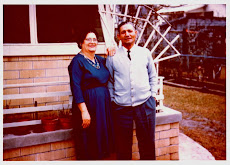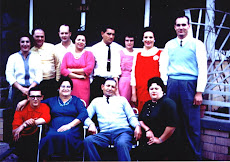
When I travel, I am always up for a new adventure, but then I am also fond of places with a tinge of the familiar.
Venice, with its meandering alley ways, peaceful piazzas and decaying architecture, put me in mind of my grandparents' native island of Hvar in the Dalmatian region of Croatia, and not a little of New Orleans.
Likewise the tiny trattorias dotting the back alleys far away from the tourist joints around San Marco, serve up food strongly reminiscent of Point Cadet: stuffed sardines, fried anchovies, pasta i fagoli, baccala, calf's liver with onion, seafood spaghetti and fried seafood platters. This really did not surprise me. For centuries, Dalmatia was ruled by the Republic of Venice and, years later, Dalmatian immigrants "ruled" the very eastern tip of Biloxi.
One of my favorite meals in Venice was my last dinner at Taverna Ciardi, a little restaurant/bar in the Cannaregio neighborhood. The menu was small, but market-driven, the mood relaxed with lots of locals (always a good sign). It was almost like eating at home -- in more ways than one.
We started with polenta topped with tiny baby Adriatic shrimp -- a Venetian version of shrimp and grits. Polenta really is just good old-fashioned stone-ground grits, the kind you so rarely get here anymore now that everybody has gone the "instant" route. These shrimp are so teensy -- much smaller than anything I've ever seen come out of the Gulf -- yet so sweet and flavorful.
Baby shrimp made their appearance again in the Spaghetti Taverna Ciardi -- which changes every day depending upon what they find at the market. Lucky for me, the market that particular day offered clams and mussels which together with garlic and white wine made for a simple, but delicious, pasta course.
For dessert, I had the taverna's signature cake studded with pears and apples and flavored with nutmeg and lemon zest. It looked like pound cake and tasted like bread pudding -- another familiar taste!
So what's the point of leaving home, you might well ask. As familiar as it was in many ways, Venice offers up many sensory delights you won't find anywhere else. Read all about them on my other blog,
"The House Where The Black Cat Lives."Until you can go yourself, here's a recipe for Taverna Ciardi-inspired shrimp with polenta, seafood spaghetti and apple-pear torta. Pour yourself a nice glass of Pinot Grigio (preferably from the Veneto region), pull up a chair to your dock (or your swimming pool or bird bath) and pretend you're sitting alongside a Venetian canal.
Salute and buon appetito!
Garlic Shrimp with Grits
The Venetians call this classic dish schie con polenta but it's okay if you just call it shrimp and grits -- that's what it is. I adapted this from a recipe in Food and Wine magazine.
6 1/2 cups water
Salt to taste (I like a lot; polenta can be kind of bland on its own)
1 3/4 cups white polenta (10 ounces). (If you can't find polenta in your neck of the woods, substitute stone-ground grits. Do not, repeat do not, use instant or quick grits. You want the kind your maw-maw used to cook.)
2 tablespoons unsalted butter
Freshly ground pepper
1/2 cup extra-virgin olive oil
2 pounds shrimp, shelled and deveined
2-3 large garlic cloves, very finely chopped
In a large saucepan, combine the water with a large pinch of salt and bring to a boil. Add the polenta in a thin stream, whisking constantly.
Reduce the heat to low and simmer, stirring constantly with a wooden spoon, until the polenta is thick and the grains are tender, about 20 minutes. Stir in the butter, season the polenta with salt and pepper and keep warm.
In a very large skillet, heat the olive oil until shimmering. Season the shrimp with salt and pepper. Add them to the skillet and cook over high heat until they are lightly browned on one side, about 2 minutes. Add the garlic, turn the shrimp over and cook until cooked through, about 1 minute longer.
Transfer the polenta to shallow bowls. Top with the shrimp and some of the garlic oil from the skillet. Serve immediately.
Spaghetti a la Taverna Ciardi
1/4 cup dry white wine
2 dozen mussels, scrubbed
2 dozen littleneck clams, scrubbed
3 tablespoons extra-virgin olive oil
4-8 garlic cloves, minced (depends on how much you love garlic. It's Halloween so I like to keep the vampires at bay and add all of them)
1/2 teaspoon crushed red pepper
1 pound spaghetti
1 pound of small shrimp or 3/4 pound medium shrimp--shelled, deveined and halved crosswise
Salt and freshly ground black pepper
2 tablespoons chopped parsley
Bring the wine to a boil in a medium saucepan. Add the mussels, cover and cook over high heat until they open, about 2 minutes. Using tongs, transfer the mussels to a bowl. Add the clams to the saucepan, cover and cook until they start to open. Transfer them to the bowl with the mussels. Pour the cooking liquid into a glass measuring cup (discard the grit if you can). Shell the mussels and clams and return to the bowl.
Heat the olive oil in a medium saucepan. Add the garlic and cook over low heat until golden, being careful not to burn. Add the red pepper and cook over moderate heat. Add the reserved shellfish cooking liquid and simmer over moderate heat until slightly reduced, about 3 minutes.
Cook the spaghetti in a large pot of boiling salted water, stirring occasionally, until al dente. Meanwhile, bring the sauce to a simmer over moderate heat. Add the shrimp and cook for 1 minute. Add the reserved mussels and clams and simmer briefly to heat through.
Drain the spaghetti and return it to the pot. Add the seafood sauce and toss to coat. Season with salt and black pepper and transfer to a warmed bowl. Sprinkle with the parsley and serve immediately.
Note: As far as I could tell, there were no tomatoes in Taverna Ciardi's sauce; however, I have had seafood spaghetti on Hvar tossed in a very light tomato-spiked seafood broth that was extremely tasty. If you would like that version, add a pint of cherry or grape tomatoes to the skillet when you add the red pepper and cook for four minutes, crushing the tomatoes with a wooden spoon as they soften, just before you add the seafood stock.
Torta with Apples and Pears
This recipe makes a very dense, rustic cake. I've also seen it made with figs. Add a pinch of cinnamon if you crave more spice.
2 1/2 cups flour
2/3 sugar
3 eggs
2/3 melted, unsalted butter
grated zest of 1 lemon
1 teaspoon baking powder
pinch of freshly ground nutmeg
1/3 cup milk
3 apples or pears or a combination. Use ripe, firm fruit.
Preheat oven to 350 degrees. Combine all ingredients except the fruit. Mix until batter is smooth.
Butter and flour a 9″ springform pan. Pour in the batter. Peel and core fruit, then slice thinly and arrange in a circle pattern on top of batter. Fruit may sink slightly into the batter.
Bake the cake until a wooden toothpick inserted into the center comes out clean, about 1 hour.
Remove from oven and let cake cool slightly on wire rack. Remove the pan sides and slip the cake onto a serving plate. Serve at room temperature.
















